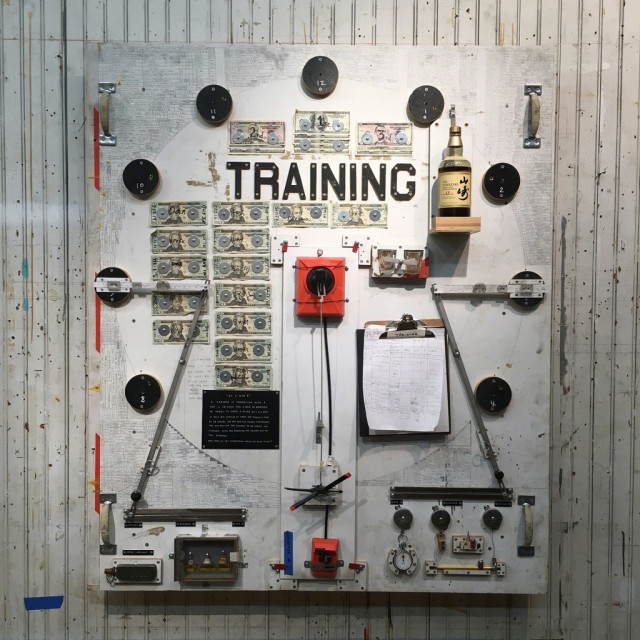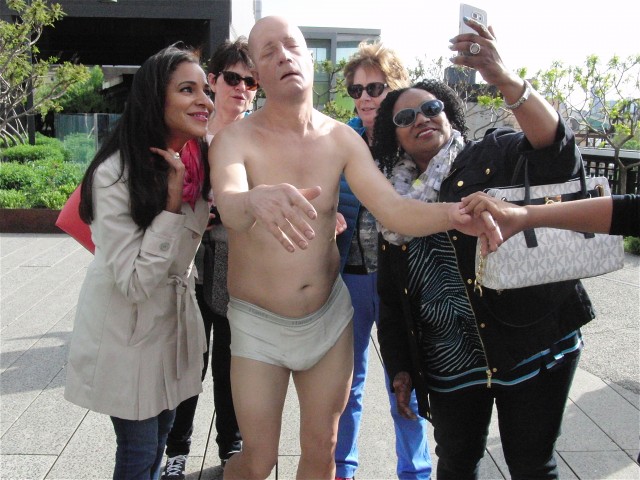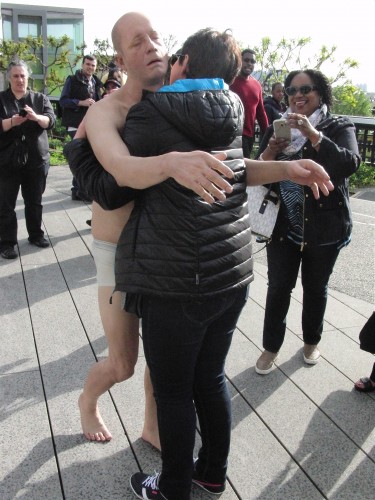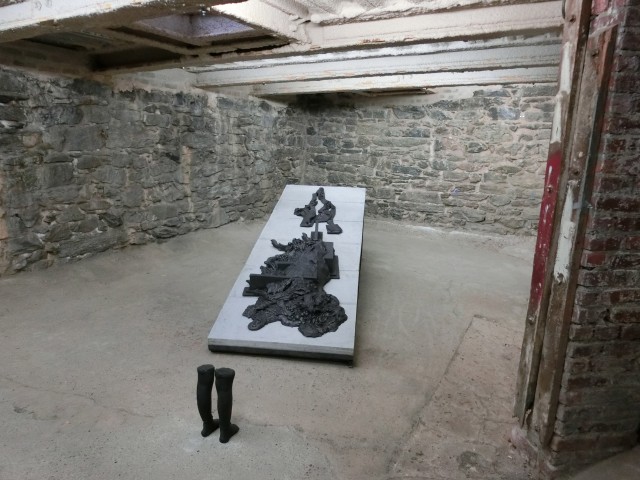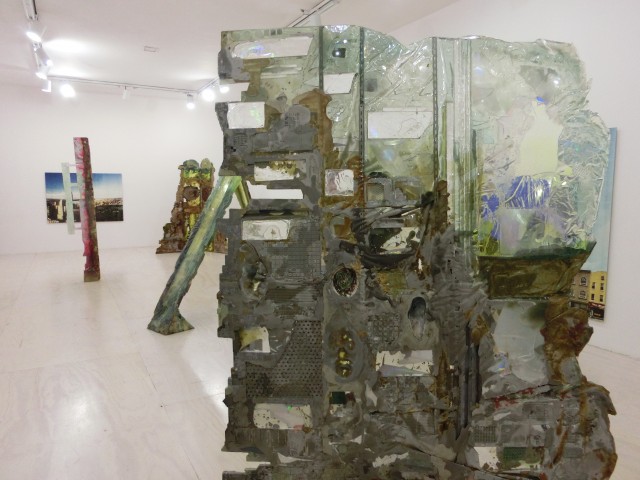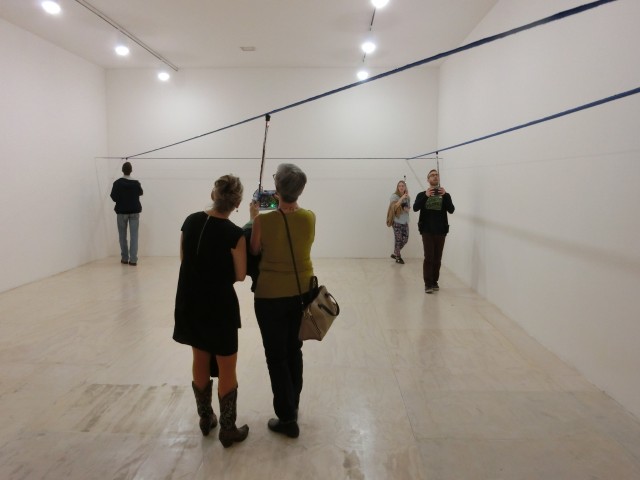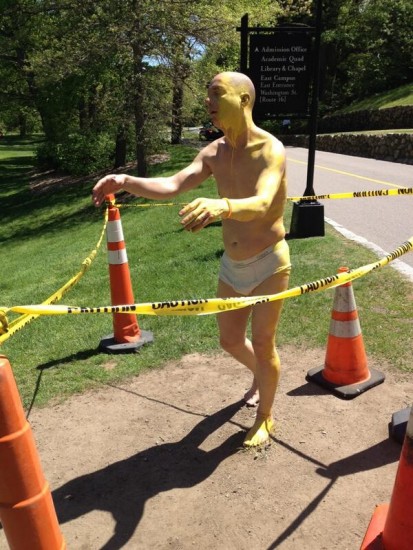
Tony Matelli’s “Sleepwalker” sculpture at Wellesley became a crime scene when vandals struck
Marlborough Chelsea
545 West 21st St. between Tenth & Eleventh Aves.
Tuesday – Saturday through August 8, 10:00 am – 6:00 pm
212-463-8634
www.marlboroughchelsea.com
www.wellesley.edu/davismuseum
Several weekends ago, after coming home from a jaunt through Chelsea galleries, I showed my wife photos I’d taken of some of my favorite works. Upon seeing one of them, she immediately said, “I think that’s the same piece that caused such a furor at Wellesley.” Indeed, I had shown her a photo of Tony Matelli’s “Sleepwalker,” a life-size painted bronze sculpture of a zombielike middle-aged white man in his underwear, eyes closed, arms outstretched, standing on the outdoor deck of the Marlborough Gallery on West 21st St. Being a sucker for lifelike sculpture — I can spend hours checking out works by Ron Mueck, Paul McCarthy, Mark Jenkins, and others — I got a huge kick out of the piece, which I found intriguing and humorous, not threatening at all, perhaps even symbolic of an America that often seems to be half asleep. However, context is everything. My wife quickly pointed out that a significant number of Wellesley students were aghast when a fiberglass cast of “Sleepwalker” had been placed outside, on campus, in February as part of the “Tony Matelli: New Gravity” exhibition at the university’s outstanding Davis Museum, the Chicago-born, Brooklyn-based sculptor’s first solo museum show. Coincidentally, we were going to Wellesley the following weekend, where we looked forward to seeing the sculpture for ourselves in an environment very different from the Chelsea deck, but sadly it had had to be removed in May, ahead of the July 20 conclusion of the exhibition, for a very surprising reason.
Shortly after the unveiling of “Sleepwalker,” which was placed outside in a wooded area near the Davis, where it could be seen from a window, hundreds of Wellesley students signed an online petition calling for the work to be moved inside the museum. The petition read in part, “Within just a few hours of its outdoor installation, the highly lifelike sculpture . . . has become a source of apprehension, fear, and triggering thoughts regarding sexual assault for some members of our campus community. While it may appear humorous, or thought provoking to some, the ‘Sleepwalker’ has already become a source of undue stress for a number of Wellesley College students, the majority of whom live, study, and work on campus.” Davis Museum director Lisa Fischman defended the installation, explaining, “Art has an extraordinary power to evoke personal response, and to elicit the unexpected. . . . Art provokes dialogue, and discourse is the core of education. In that spirit, I am enormously glad to have your response.”
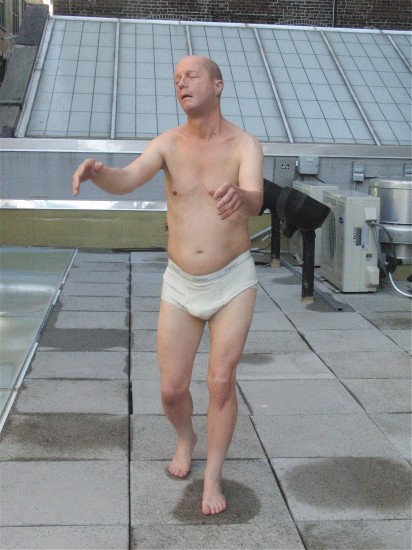
“Sleepwalker” will stay up at the Marlborough Chelsea through August 8 (photo by twi-ny/mdr)
Matelli himself chimed in on the debate, telling CBS Boston, “I think that these people are misconstruing this work. I think they’re seeing something in this work that isn’t there. But who am I to say how people should react to this?” He added, “I don’t think they’ll take the statue down. But if they make that decision, that’s fine with me.” I’m not sure it’s fine with Matelli why it ultimately had to be taken down; first, a student (since suspended) spray-painted the statue yellow, her class color (she did the same to Matelli’s nearby small dog sculpture), then a still-unidentified perp broke the five-foot, nine-inch-high “Sleepwalker” at its ankles, apparently in an effort to kick it down. I was shocked when I saw photos of the damage, which totaled the work, leaving it irreparable; was this really possible at such a liberal, free-thinking college as Wellesley? Is this type of censorship any different from Attorney General John Ashcroft and deputy director of public affairs Monica Goodling using a blue curtain to cover up the partially nude “Spirit of Justice” Art Deco aluminum statue in the Great Hall of the Justice Department in 2002? Or when performance artist Alexander Brener spray-painted a green dollar sign over Kazimir Malevich’s “Suprematisme 1920-1927” in 1997 in protest of the commercialism of art? (“I view my act as a dialogue with Malevich,” Brener said in court.) During the Wellesley reunion weekend, I spoke with numerous current and former students of all ages, and each had an individual reaction to the installation of “Sleepwalker” itself and to the eventual damage. Some felt that art is art and people should “get a life” and not interpret everything so personally. Others believed it was a gross error on the part of the museum and the school to put a statue so suggestive to survivors or victims of sexual abuse outside, near a wooded area, at a woman’s college. Fortunately, no one was in favor of the vandalism. Yes, it’s encouraging that a work of art elicited such strong personal feelings on many fronts, but have we become a bunch of whimpering souls, not able to look the other way when it comes to an inanimate sculpture that means different things to different people? If something is displeasing to some but not to others, must it be wished away into the cornfield, hidden where no one will ever see it? Or is it further evidence that the gender divide is still much larger than we imagined, even at such an illustrious college as Wellesley? You can check out Matelli’s “Sleepwalker” at the Marlborough through August 8, but, of course, you’ll never be able to see the Wellesley version.
